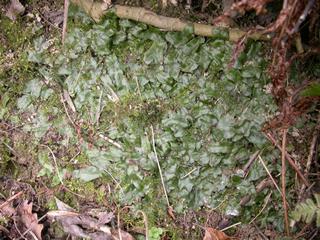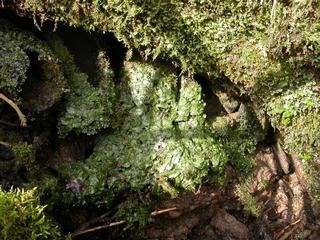

Worcestershire Record No. 20 April 2007 p. 20
Tessa Carrick
There have always been a few species of the large, flattened thalloid liverworts which I could identify with confidence – Lunularia cruciata with its crescent shaped cups, Marchantia polymorpha with its round cups and the massive Conocephalum conicum which grows on wet sites, sometimes coating the banks of streams. Things have suddenly changed – the Conocephalum found in the United Kingdom has been recognised to be two species – Conocephalum conicum L. Dumort. (or Greater Scented Liverwort) and Conocephalum salebrosum Szweykowski, Buczkowska and Odrzykosli.
This new situation was described in a recent issue of Field Bryology (Blackstock et al., 2005). The two species were originally distinguished by isozyme studies (Szweykowski et al, 2005), that is studies of the multiple forms of enzymes which catalyse certain reactions. Fortunately, it is possible to distinguish the species morphologically.
This new situation means that previous records assigned to Conocephalum conicum may not be correct. We need to check the Conocephalum growing in Worcestershire to decide whether we have both species here and, if so, the distribution of each. So far, I have found Conocephalum salebrosum only along the Dumbleton Brook in Hunthouse Wood very close to patches of Conocephalum conicum. But, I’ve only examined a few sites.
The challenge: Please help us check Conocephalum in this county. We need records and specimens from each site. The specimens should not be too wet when packed and should be in a package which protects them from crushing in the post. The records with situation, location name, Grid Reference, finder’s name, date, etc. should be sent with a specimen to: Dr. Chris Preston, CEH Monks Wood, Abbots Ripton, Huntingdon, Cambs PE28 2LS
It would also be helpful for our county records if the same information could be sent to me – Mrs. T. Carrick, 29 Malvern Road, Bromsgrove B61 7HE or tessa@carrickt.fsnet.co.uk
The table shows field* and microscopic characters (after Blackstock et al., 2005):
| Character | C.conicum | C.salebrosum |
| Size of plant* |
Usually large 50-110(-135) mm long 8-12(16) mm wide |
Smaller and narrower
(20)-30-60(-190) mm long 5-10(-12.5) mm wide |
| Texture and pattern of dorsal surface* | Shiny, with pores conspicuous but borders between air chambers inconspicuous | Dull (unless wet) with borders of air chambers more conspicuous than pores so thallus has a reticulate pattern |
| Smoothness of dorsal surface* | Smooth; junctions of air chambers flush with surface | Undulating; junctions of air chambers in shallow valleys in thallus |
| No. of air chambers between midrib and the edge of thallus | Usually 5-8(-9) | 3-5(-6) |
| Number of rows of +/- elongated, hyaline cells at thallus margin | (2-)3-4(-5) | 2-3 |
| Junction of air chamber wall with dorsal epidermis | Highest cell of air chamber wall reaches dorsal epidermal cells but is not inserted between them | Highest cell of air chamber inserted between dorsal epidermal cells |
| Shape of hyaline cells in layer immediately below pores | Flask-shaped | Pyriform |
 |
 |
| Two pictures of Conocephalum conicum, a sheet of thalloid liverwort. The English name for Conocephalum salebrosum is still being debated but Snakewort, used in America, may be adopted here, too. | |
References:
| Blackstock, T. H., Bosanquet, S. D. S., Long, D. G. and Preston, C. D. (2005) Conocephalum in Britain and Ireland: a BBS mini-survey. Field Bryology 87: 11-14 | |
| Szweykowski, J., Buczkowska, K., and Odrzykowski, I. J. (2005) Conocephalum salebrosum (Marchantiopsida, Conocephalaceae) – a new Holarctic liverwort species. Plant Systematics and Evolution 253:133-158. |
Web-site:http://rbg-web2.rbge.org.uk/bbs/Recording/conocephalum/conosurvey.htm
| WBRC Home | Worcs Record Listing by Issue | Worcs Record Listing by Subject |